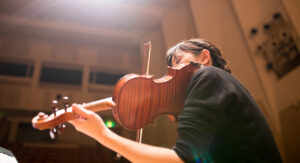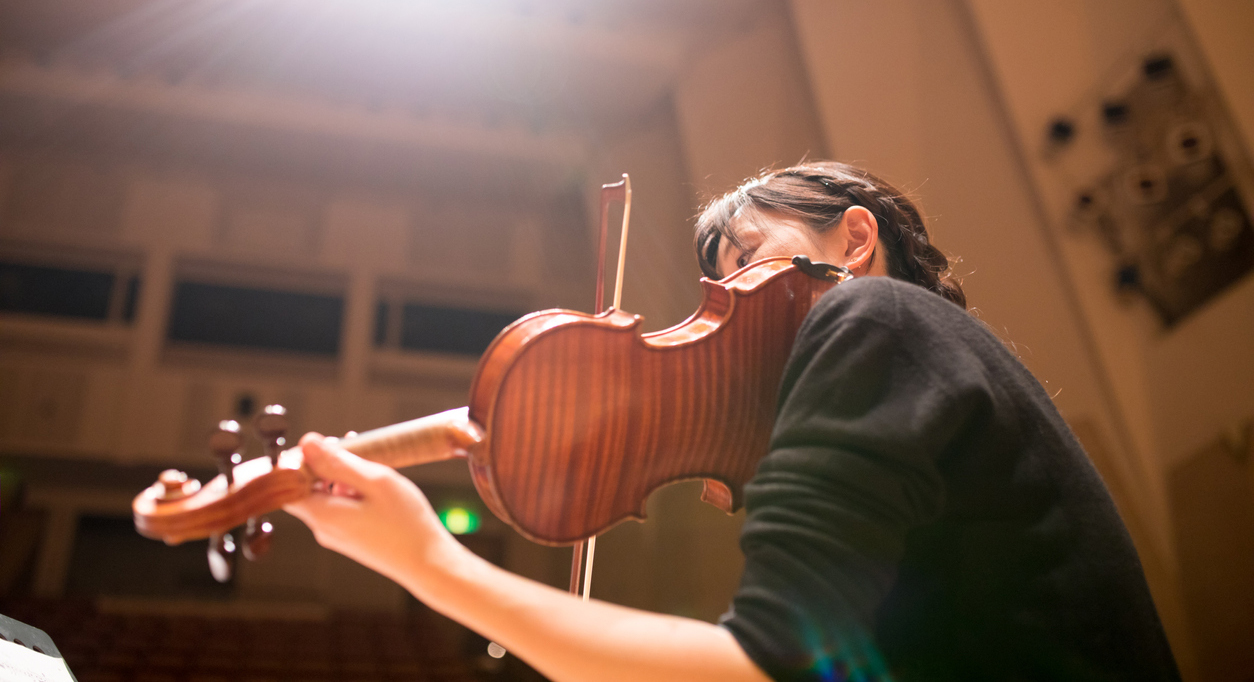The best bow for violin optimizes sound quality and playability. Selecting a high-quality bow like the Fiddlerman Carbon Fiber Violin Bow enhances performance.
Choosing the right violin bow is as crucial as the instrument itself. It can dramatically affect your violin’s sound and the ease with which you can play. The perfect bow acts as an extension of the violinist’s arm, allowing for fluid, nuanced expressions and dynamic control.
In the market, materials range from traditional Pernambuco wood to innovative carbon fiber, each offering distinct qualities. Top violinists often prefer bows from reputable makers or brands, with many gravitating towards handcrafted pieces for their unique characteristics. The Fiddlerman Carbon Fiber Bow stands out due to its durability, affordability, and ability to produce a warm, rich tone akin to wooden bows. Beginners and professionals alike consider factors such as weight, balance, and flexibility when selecting a bow to ensure they achieve the best sound and technical performance from their violin.
Professional Choices In Bows
Choosing the right bow is as essential to a violinist as selecting the violin itself. For professionals, the bow becomes an extension of their expressive capabilities, a tool that must respond to the slightest nuance in their technique. Below, we explore the characteristics of high-caliber bows and gather respected recommendations from professional violinists to guide you in your quest for the perfect bow.
Characteristics Of Performance-grade Bows
Performance-grade bows share a set of qualities that set them apart from beginner or intermediate models:
- Superior Materials: Professional bows typically feature high-quality Pernambuco wood or advanced carbon fiber composites for optimal balance and flexibility.
- Balance and Weight: An ideally balanced bow ensures ease of handling, allowing for effortless control and articulation.
- Responsiveness: A bow that reacts quickly to changes in bowing technique is indispensable for advanced playing.
- Sound Production: A great bow enhances the violin’s tone, providing a wide range of colors and dynamics.
- Craftsmanship: Expert construction and attention to detail in the frog, winding, and tip all contribute to the overall performance and durability of the bow.
Recommendations From Professional Violinists
Professional opinions are invaluable when searching for a high-quality bow. Here’s a table summarizing top recommendations:
| Bow Maker | Material | Price Range | Preferred For |
|---|---|---|---|
| Dominique Peccatte | Pernambuco | $$$$ | Richness of tone |
| Eugène Sartory | Pernambuco | $$$$ | Balance and power |
| Arcus | Carbon Fiber | $$$ | Modern agility and stability |
| CodaBow | Carbon Fiber | $$$ | Versatility and durability |
Experienced violinists often praise the traditional craftsmanship of bows by historic makers like Dominique Peccatte and Eugène Sartory, citing their unparalleled ability to coax a complex and warm sound from the violin. For those seeking innovative construction, bows by Arcus and CodaBow are lauded for their modern materials that offer resilience and consistency.
Beyond endorsements, it’s crucial for players to experience how these bows handle personally, as the bow that best complements an individual’s style can transform their music profound. The quest for the ideal bow is a unique journey and an investment in your musical excellence.

Credit: manhattan.institute
Understanding Violin Bow Materials
When embarking on the quest to find the best bow for violin, considering the materials used to craft the bow is paramount. Violin bows are not just a tool, but an extension of the musician’s body that greatly influences the sound and playability of the violin. From traditional woods to modern synthetics, the materials selected in bow-making directly affect a bow’s performance and durability.
Different Types Of Wood And Synthetic Materials
Historically, violin bows have been made from a variety of woods. Commonly preferred is Pernambuco, a dense, flexible wood renowned for its superior acoustic properties. Let’s delve into the different materials used in violin bows:
- Pernambuco: Traditionally the most coveted wood for bows due to its elasticity, strength, and rich tonal quality.
- Brazilwood: Often used for student bows, it’s a more affordable yet effective alternative to Pernambuco.
- Fiberglass: Lightweight and affordable, fiberglass bows are a durable choice for beginners.
- Carbon Fiber: Known for their resilience and consistency, carbon fiber bows offer advanced musicians a modern alternative that can mimic the qualities of wooden bows.
Advancements in technology have seen the rise of synthetic materials, such as carbon fiber, which are engineered to provide durability and consistency in performance.
Impact Of Materials On Performance And Durability
The material of a violin bow significantly influences its performance and long-term durability. To understand this impact, consider the following points:
| Material | Performance | Durability |
|---|---|---|
| Pernambuco | Excellent responsiveness and nuanced sound production | Highly durable with proper care, susceptible to climate changes |
| Brazilwood | Good for students, typically produces a warmer tone | Moderate, can degrade with excessive use |
| Fiberglass | Limited nuance in sound, but consistent | Very durable and resistant to warping |
| Carbon Fiber | Can rival Pernambuco’s performance, with great sound clarity | Extremely durable, unaffected by weather conditions |
Pernambuco bows react sensitively to a player’s touch and can last generations, while Brazilwood offers adequate quality for those beginning their musical journey. For those seeking minimal maintenance, fiberglass and carbon fiber bows both provide high durability and resistance to environmental conditions, although carbon fiber is superior in mimicking the nuanced performance of wood.
Choosing the best bow for violin entails understanding these materials’ attributes. Opting for the suitable material aligns with the musician’s skill level and artistic demands, ensuring a bow that enhances performance and stands the test of time.
Criteria For The Best Bow
Finding the best bow for violin can significantly enhance your playing experience. The bow is an integral part of producing the desired tone and expresses the violinist’s intent through its interaction with the strings. To aid in your selection, the criteria for the best bow can be broken down into several key factors that violinists should consider:
Weight And Balance
An ideal violin bow strikes the perfect balance between weight and balance. It should feel like an extension of the hand. A bow that is too heavy may cause fatigue, while a too-light bow can lead to a lack of control and power. A well-balanced bow has a center of gravity that allows for fluid movements and a natural hold.
- Preferred weight range: Generally, a weight of around 60 grams is suitable for most players.
- Balance point: Approximately 1/3 of the way from the frog to the tip.
Hair Quality And Tension
The hair on the bow plays a pivotal role in producing sound. High-quality horsehair, typically white and unbleached, is the standard choice for the best bow for violin. The tension should be adjustable, allowing the bow to grip the strings with just the right amount of pressure.
| Hair Characteristics | Benefits |
|---|---|
| Sufficient density | Ensures good contact with string |
| Proper rosin application | Facilitates smooth bowing and sound production |
| Adjustable tension | Accommodates different playing styles and conditions |
Comfort And Grip
The ergonomics of a violin bow are crucial for long sessions. The best bow for violin should have a comfortable and secure grip. This not only prevents the hand and arm strain but also promotes proper technique. Look for a bow with a well-crafted frog that fits the hand’s natural shape and a thumb grip made from soft material such as leather or rubber.
- Confirm the thumb grip material is conducive to extended play.
- Check the frog’s shape for a natural and comfortable hand position.
- Ensure the bow’s stick does not wobble in the hand, indicating a secure grip.
Personalizing Your Violin Sound
Every violinist knows that the bow is not just an accessory, it’s a vital component that shapes their music’s voice. To truly make a piece of music resonate with your personal touch, selecting the best bow for violin is key. A bow can change the timbre, dynamics, and articulation of each note you play. It’s about finding the right partner for your violin that complements your playing style and enhances your overall sound.
Aligning Bow Choice With Playing Style
Understanding the interaction between your bow and playing style is crucial. A bow that matches your approach can elevate your performance to new heights.
- Aggressive players might prefer a heavier, stiffer bow that can deliver powerful, bold strokes.
- Those aiming for nuanced expression may lean towards a lighter bow, allowing for delicate control and subtlety.
- Players with a fast tempo style might seek a well-balanced bow for quick, responsive action.
The right bow serves as an extension of your technique, bringing the music to life as it was intended to be heard.
Experimentation And Finding Your Unique Sound
Creating your signature sound doesn’t happen overnight. It emerges from a process of experimentation.
- Sample a variety of bows across different materials, weights, and balances.
- Pay attention to how each bow responds to your style of playing.
- Take note of the sound quality and ease of playability.
- Seek feedback from mentors and peers to understand how your sound projects with each bow.
Exploring different bows is an exploration of your musical identity. With patience and practice, you’ll identify the best bow for violin that truly speaks your musical language.
Role Of Bows In Sound Production
A masterfully crafted bow plays an integral role in creating the rich and diverse sounds emitted from a violin. Much like a skilled conductor leads an orchestra, the best bow for violin guides the instrument to perform at its peak, allowing for a range of expressions – from the most delicate pianissimo to the most powerful fortissimo. A bow must be both a precision tool and an extension of the artist, as it directly influences tone, texture, and the overall acoustic signature.
Understanding how a bow interacts with the strings, and the plethora of techniques used to produce varied tones, is essential for violinists seeking to hone their craft. Let’s delve into the specifics:
How The Bow Interacts With Violin Strings
The interaction between bow and string is a dance of physics and finesse, where the bow hairs create friction against the strings, resulting in vibrations that form sound. The quality of the bow hair, typically horsehair, and its rosin coating contribute significantly to the effectiveness of this interaction. The tighter the bow hair tension, the more precise and crisp the sound. Conversely, a looser tension may imbue the music with a richer, fuller body.
The angle and speed at which the bow crosses the strings, alongside the point of contact, can alter the sound dramatically. The sweet spot for playing is typically near the bridge, where the strings offer the right amount of resistance for a robust sound, while playing closer to the fingerboard yields a softer, mellower tone.
Techniques For Producing Various Tones
- Legato: This technique involves smooth, long strokes across the strings, producing a continuous, flowing sound without any apparent breaks.
- Staccato: Staccato calls for short, sharp strokes with a clear stop between notes, resulting in a more percussive sound.
- Spiccato: By allowing the bow to bounce lightly on the strings, spiccato creates a lively, articulated effect with a gentle ‘off the string’ movement.
- Col legno: A rather unique technique where the violinist uses the wood of the bow to strike the strings, rendering a muted percussive sound.
- Sul tasto: Playing over the fingerboard with a lighter bow pressure for a flautando effect, producing an ethereal, delicate sound.
- Sul ponticello: Drawing the bow near the bridge tightens the string’s vibrations, resulting in a tense, metallic sound.
Each of these techniques demands control and precision, qualities embodied by the best bow for violin. With the right bow in hand, a violinist can explore the full sonic spectrum of their instrument, captivating audiences with the rich tapestry of sounds at their disposal.
Factors To Consider For Beginners

Choosing the best bow for violin as a beginner involves several crucial considerations. From ensuring value for money to finding the right fit for a student’s frame, the right bow can significantly impact the learning process. Let’s delve into the aspects new learners should weigh before making their selection.
Price Versus Quality For New Learners
Determining the balance between price and quality is fundamental for beginners. While professional-grade bows may be cost-prohibitive, investing in the cheapest option might hinder progress and even damage the violin. A solid starting point is to look for a best bow for violin that offers durability, a good weight balance, and smooth playability without breaking the bank. Here are key points to consider:
- Material: Look for carbon fiber or high-quality Brazilwood — both options offer resilience and good playability at reasonable prices.
- Weight and Balance: A well-balanced bow ensures easier control, which is essential for developing proper technique.
- Hair Quality: Horsehair is the standard, but ensure it’s neither too slippery nor too grabby to allow for a clean sound.
Size And Suitability For Young Players
The size of the violin bow is a non-negotiable factor, especially for young players. The right size bow parallels the player’s arm length and violin size, providing comfortable playability and preventing strain. Here’s a simplified guide:
Add additional rows as needed for other sizes.
| Violin Size | Bow Length |
|---|---|
| 1/16 Violin | 16″ Bow |
| 1/10 Violin | 17.5″ Bow |
| 1/8 Violin | 19″ Bow |
Rental programs can be a valuable resource for growing students, offering the opportunity to upgrade the bow and violin as needed. Ensure the chosen bow feels comfortable in hand and allows for a natural and relaxed posture.
Caring For Your Violin Bow
The violin bow, as much as the violin itself, is integral to producing beautiful music. Consistent maintenance and proper care can greatly extend its life and ensure that you’re always performing at your best. Below are important tips and practices to preserve the quality and playability of what might just be the best bow for violin you own.
Proper storage and handling
Proper Storage And Handling
- Always loosen the bow hair after playing to relieve tension and prevent warping of the wood.
- Handle your bow by the frog to minimize oils and dirt from hands transferring to the wood and hair.
- Use a hard case with bow holders that secure your bow in place to prevent unnecessary jostling and potential damage.
- Avoid exposing your bow to extreme temperatures and humidity, which could cause it to warp or the hair to stretch.
Tips for rehairing and when to do it
Tips For Rehairing And When To Do It
Rehairing your violin bow is necessary because bow hair wears out with use. Recognize when it’s time by looking for these signs:
- Hair looks discolored, matted, or unevenly spread across the bow.
- Decreased grip on the strings, meaning you have to apply more pressure for proper sound production.
- Visible hair breakage or loss, more than just a few strands.
Seek a professional for rehairing every 6 to 12 months, depending on your playing frequency, to guarantee the best sound and responsive grip.
Preserving Bow Longevity
Preserving the longevity of your violin bow involves several key practices:
| Action | Benefit |
|---|---|
| Regular cleaning | Removes rosin buildup and preserves hair quality. |
| Periodic inspections | Helps catch issues early, such as cracks in the wood. |
| Proper tensioning | Protects the camber of the bow stick, maintaining its curve. |
Implement these practices with your best bow for violin, and it will serve you well for years to come.
Modern Developments And Brands
The quest for the best bow for violin has led to remarkable innovations in recent years. Both budding and seasoned violinists now have access to a vast array of choices thanks to modern developments in materials, design, and craftsmanship, not to mention the prestigious brands that have become synonymous with quality in the world of string instruments.
Advancements In Bow Technology
Today’s violin bows are not just pieces of wood strung with horsehair. Cutting-edge technology and new materials have revolutionized the way we think about these crucial tools:
- Carbon Fiber: Carbon fiber bows are now popular for their durability and resilience, capable of withstanding the rigors of travel and climate variations without warping.
- Improved Balance: Precision engineering ensures optimal weight distribution along the length of the bow, leading to easier handling and more nuanced control for the player.
- Advanced Horsehair: Enhanced treatments and selection processes for horsehair have improved the consistency and response of bows, offering a smoother playing experience.
Overview Of Reputable Bow Makers And Brands
Several reputable names stand out when discussing the best bow for violin. Here’s an overview of acclaimed makers and brands:
| Brand Name | Type of Bows | Key Qualities |
|---|---|---|
| CodaBow | Carbon Fiber | Innovative design, durability, and consistency |
| JonPaul | Carbon Fiber and Hybrid | Suitability for professional and advancing players |
| Arcus | Carbon Fiber | Lightweight and responsive with sleek aesthetics |
| Dörfler | Traditional Wood | High-quality German craftsmanship |
Frequently Asked Questions On Best Bow For Violin
What Are The Qualities Of A Great Violin Bow?
A great violin bow should have the right balance, flexibility, and weight for smooth playing. It needs to be made from quality materials like Pernambuco or carbon fiber, allowing for better control and sound production.
How Does Bow Material Affect Violin Sound?
The material of a bow significantly influences the sound. Pernambuco wood bows offer warm, rich tones while carbon fiber bows provide consistency and a brighter sound. The choice depends on personal preference and playing style.
Can Beginners Benefit From A High-quality Bow?
Yes, beginners can see notable improvements with a high-quality bow. A good bow enhances ease of playing, sound, and overall technique, making the learning process smoother and more enjoyable.
How Often Should I Replace My Violin Bow?
Violin bows don’t have a set expiration date, but should be rehaired every 6-12 months depending on usage. Replace the bow if it’s damaged or no longer produces the desired sound quality.
Conclusion
Selecting the ideal violin bow is pivotal to mastering your performance. Evaluate each bow’s weight, balance, and material before deciding. Remember, the right choice blends both comfort and sound quality, enhancing your musical journey. Keep practicing, and let your new bow guide you to violin mastery.
To check our more blogs Click Here



